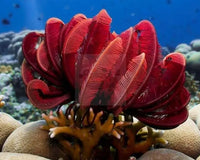As a rule, it is prescribed that an aquarist should purchase the biggest tank he can bear the cost of and has space for. There are many purposes behind this. The bigger the tank, the slower water quality changes are, and a dead fish or bit of extra nourishment in a huge tank will have less general impact than one of every a modest tank. All things considered, a fish biting the dust in a waterway has next to zero impact, however a fish passing on in a teacup will quickly dirty the water. Likewise the bigger the tank, the more noteworthy number and assortment of fish can be kept.
Be that as it may, this is not to recommend that a little tank is difficult to keep. On the off chance that you are on an exceptionally constrained spending plan, or just have a little measure of room, a little tank can, with mind, be as wonderful and intriguing as a huge one. While picking a little tank, you should know that similar guidelines apply to little tanks as to huge ones. One inch of tropical fish can be kept per square inch of water surface (the length of a fish is measured from the nose to the start of the tail balance, and does exclude the tail itself). In light of this control, on the off chance that you pick one of the taller tanks with a littler water surface, you will have the capacity to keep less fish than in one of the standard rectangular ones, with a more prominent water surface. On the off chance that you pick a little, 'non-standard' size, you may experience issues getting a tank hood or lighting, so make sure to consider this when purchasing your aquarium.
Once your little tank is furnished with water, warming, filtration, and lights, you might need to pick a few plants to aquascape it. In the event that you have picked undergravel filtration, your selection of plants will be more constrained, as most plants don't care for the water moving around their underlying foundations. You could pick plastic plants, or there are still a few plants which will flourish even with an undergravel channel. One of these is Java greenery (Vesicularia dubyana). This is a superb plant for most aquaria, and perfect for a little one. Like the greenery that develops on clearing stones, it will grasp to any surface and can be reduced without hurt. Fix it set up on stones or bogwood with string or elastic groups, and in a brief timeframe the greenery will be solidly fastened. A watchful selection of bits of stylistic theme combined with the greenery can add stature to your show and give an extremely common impact. Anubias nana is a moderate developing plant with dull green leaves, which can either be established in the rock or settled, similar to Java greenery, to a bit of stylistic layout, which the roots will in the end hold immovably. Like the greenery, this plant will coincide cheerfully with an undergravel channel, and may significantly bloom. For a tank with delicate to nonpartisan water, there is an expansive decision of Cryptocoryne species accessible. These plants frequently drop the vast majority of their leaves when initially planted, yet with a little tolerance and at least unsettling influence they will thrive.
At the point when a fish is added to another tank, it promptly begins to dirty the water by its normal discharge forms. On the off chance that you have picked a concoction channel, at that point these toxic substances will be expelled from the water, yet in the event that you have picked an organic channel (undergravel or wipe) at that point the filtration can't begin promptly. This is on account of the channel just contains a miniscule number of microbes, and it is the microscopic organisms in the channel that expel the toxins from the water. As the fish discharges, the microscopic organisms will start to increase to exploit this new largesse of nourishment, however this is a moderate procedure. This happens in any new tank, yet in a little one, as examined prior, poisons in the water are less weaken and can achieve deadly levels rapidly. At the point when the channel can't process the squanders rapidly enough, the water ends up noticeably harmful, and the fish begin to pass on. This is known as 'New Tank Syndrome'. You can maintain a strategic distance from this by including the new fish each one in turn, and holding up a fortnight before including another. There are likewise 'channel begin' arrangements accessible that contain the channel microscopic organisms, and dosing the tank with one of these two or three days after each new fish is included can help maintain a strategic distance from New Tank Syndrome. If you are not fretful, and are mindful so as to check water quality and perform upkeep, for example, expulsion of dead leaves and water changes, at that point your little fish ought to experience the ill effects of no issues.
Whatever fish you decide for your smaller than usual aquarium, by taking appropriate care of them and considering their requirements your tank can be as excellent as a significantly bigger one. To be sure, in the event that you later have the space or the cash to grow, you may find that the new bigger tank is as yet supplied with the modest and wonderful fish that can make a little aquarium a microcosm of excellence and premium.





